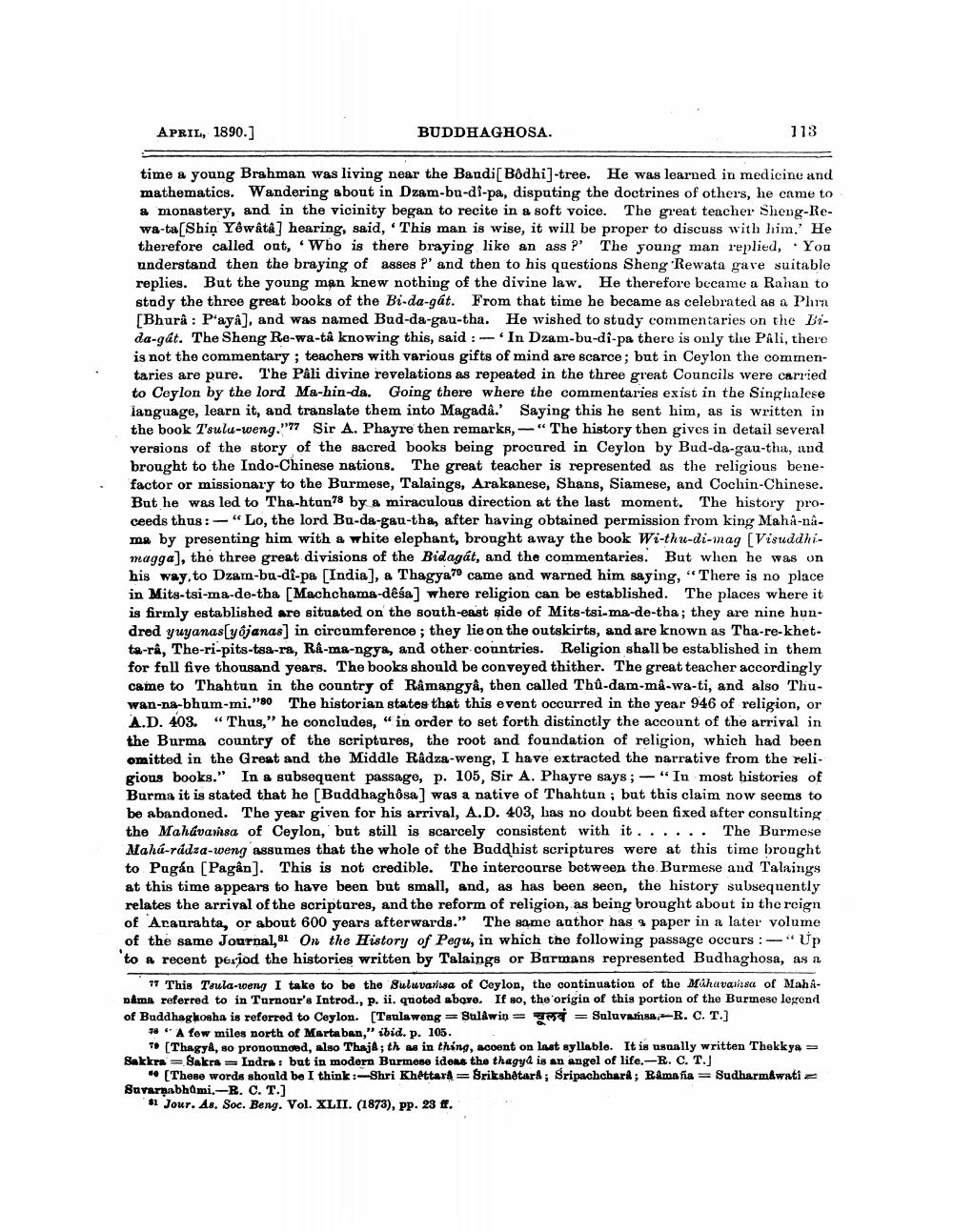________________
APRIL, 1890.]
BUDDHAGHOSA.
113
time a young Brahman was living near the Baudi[ Bodhi]-tree. He was learned in medicine and mathematics. Wandering about in Dzam-ba-di-pa, disputing the doctrines of others, he came to & monastery, and in the vicinity began to recite in a soft voice. The great teacher Sheng-Rewa-ta[Shiņ Yêwatâ] hearing, said, “This man is wise, it will be proper to discuss with him.' He therefore called out, Who is there braying like an ass ?' The young man replied, You understand then the braying of asses ?' and then to his questions Sheng 'Rewata gave suitable replies. But the young man knew nothing of the divine law. He therefore became a Rahan to study the three great books of the Bi-da-gát. From that time he became as celebrated as a Phra [Bhura : Paya), and was named Bud-da-gau-tha. He wished to study commentaries on the Bida-gát. The Sheng Re-wa-tå knowing this, said: - In Dzam-bu-di-pa there is only the PAli, there is not the commentary ; teachers with various gifts of mind are scarce; but in Ceylon the commentaries are pure. The Pali divine revelations as repeated in the three great Councils were carried to Ceylon by the lord Ma-hin-da. Going there where the commentaries exist in the Singhalese language, learn it, and translate them into Magada.' Saying this he sent him, as is written in the book Tsulu-weng."77 Sir A. Phayre then remarks, -" The history then gives in detail several versions of the story of the sacred books being procured in Ceylon by Bud-da-gau-tha, and brought to the Indo-Chinese nations. The great teacher is represented as the religious benefactor or missionary to the Burmese, Talaings, Arakanese, Shans, Siamese, and Cochin-Chinese. But he was led to Tha-htan78 by a miraculous direction at the last moment. The history proceeds thus:-"Lo, the lord Bu-da-gau-tha, after having obtained permission from king Maha-nama by presenting him with a white elephant, bronght away the book Wi-thu-di-mag (Visuddhimagga], the three great divisions of the Bidagát, and the commentaries. But when he was on his way,to Dzam-bu-di-pa [India], a Thagya79 came and warned him saying, "There is no place in Mits-tsi-ma-de-tha Machchama-desa] where religion can be established. The places where it is firmly established are situated on the south-east side of Mits-tsi-ma-de-tha; they are nine hundred yuyanas[yôjanas] in circumference; they lie on the outskirts, and are known as Tha-re-khet. ta-rå, The-ri-pits-tsa-ra, RA-ma-ngya, and other countries. Religion shall be established in them for full five thousand years. The books should be conveyed thither. The great teacher accordingly came to Thahtun in the country of Râmangyâ, then called Thû-dam-ma-wa-ti, and also Thuwan-na-bhum-mi.”80 The historian states that this event occurred in the year 946 of religion, or A.D. 403. “Thus," he concludes, "in order to set forth distinctly the account of the arrival in the Burma country of the scriptures, the root and foundation of religion, which had been omitted in the Great and the Middle Râdza-weng, I have extracted the narrative from the religious books." In a subsequent passage, p. 105, Sir A. Phayre says; - "In most histories of Burma it is stated that he (Buddhaghôsa] was a native of Thahtun; but this claim now seems to be abandoned. The year given for his arrival, A.D. 403, has no doubt been fixed after consulting the Mahavamsa of Ceylon, but still is scarcely consistent with it...... The Burmese Mahá-rádza-weng assumes that the whole of the Buddhist scriptures were at this time brought to Pagán [Pagån). This is not credible. The intercourse between the Burmese and Talaings at this time appears to have been but small, and, as has been seen, the history subsequently relates the arrival of the scriptures, and the reform of religion, as being brought about in the reign of Acaurahta, or about 600 years afterwards." The same author has , paper in a later volume of the same Journal,81 On the History of Pegu, in which the following passage occurs : -"Up to a recent period the histories written by Talaings or Barmans represented Budhaghosa, as a
17 This Tsula-weng I take to be the Suluvansa of Ceylon, the continuation of tho Mahavainsa of Mahanama referred to in Turnour's Introd., p. ii. quoted above. If so, the origin of this portion of the Burmese legend of Buddhaghosha is referred to Ceylon. [Tsulaweng = Sulwin = M = Suluvatsa-R. C. T.]
58 "A few miles north of Marta ban,” ibid. p. 105.
T* [Thagyd, so pronounced, also Thaja; th as in thing, acoent on last syllable. It is usually written Thekkya = Sakkra= Bakra = Indra: but in modern Burmese ideas the thagyd is an angel of life.-R. C. T.]
*(These words should be I think :- Shri Khêttars=Srikshêtard; Sripachchara; Rámafia = Sudharmawati = Suvarnabhumi.-R. C. T.]
$1 Jour. As. Soc. Beng. Vol. XLII. (1873), pp. 23 ff.




